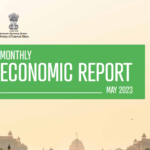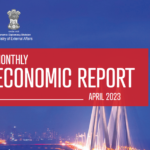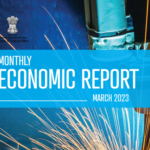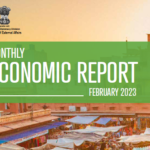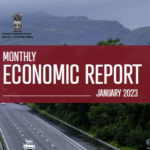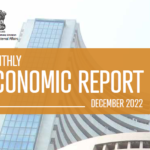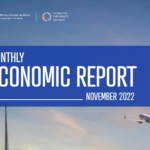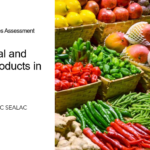-

Monthly Economic Report: May 2023
India’s macroeconomic management has been commendable despite unprecedented global challenges and domestic balance sheet issues in the banking and corporate sectors. It has significantly contributed to enhancing macroeconomic stability and enabling a faster recovery compared to other countries.
-

Monthly Economic Report: April 2023
With sustained growth, increased capacity utilization triggering 75% investment, corporates are now investing in new capacity. Capital goods and construction/infrastructure goods production, as estimated in the IIP, grew steadily in Q4 of FY23, along with imports of capital goods. India benefits from strong domestic demand with consistent and widespread growth in consumption and traction in capacity creation and real estate investment. Although it is too early to make definitive predictions for the entire year, the promising start to the financial year indicates positive prospects in the future.
-

Monthly Economic Report: March 2023
India’s economy has shown strength in FY23, and it is estimated to grow at 7%, higher than the trend rate and the growth of other major economies. The growth is supported by improving macroeconomic stability, such as an improved current account deficit, easing inflation pressure, and a strong banking system that can withstand policy rate increases. The April 2023 update of the WEO predicts India to be the fastest-growing economy in FY24, with even more robust stability in macroeconomic variables.
-

Monthly Economic Report: February 2023
The Indian economy is projected to grow at 7% in 2022-23, despite external challenges. Real GDP estimates for Q3 of 2022-23 reaffirm the ability of the Indian economy to grow on the strength of its domestic demand even as a rise in global uncertainties slows global output.
-

Monthly Economic Report: January 2023
The Union Budget FY24 includes measures such as increased capital expenditure, infrastructure development, green economy initiatives, and strengthening of financial markets, expected to promote job creation and spur economic growth. Additionally, measures for the MSME sector are expected to aid small enterprises by reducing the cost of funds. The revision of tax slabs under the New Personal Income Tax Regime is predicted to boost consumption, providing impetus to economic growth. Easier KYC norms, expansion of DigiLocker services, and a focus on digitisation and last-mile connectivity are also expected to strengthen financial markets. Despite potential risks, the Indian economy is confident thanks to a history of macroeconomic stability.
-

Monthly Economic Report: December 2022
Despite global challenges, international agencies are still forecasting India as the fastest-growing major economy, with a projected growth rate of 6.5-7.0% in FY23. This positive outlook is due to the resilience of the Indian economy, particularly with the rebound of private consumption replacing exports as the main driver of growth. The increase in private consumption has led to a boost in production activity, resulting in a rise in capacity utilization across industries.
-

Union Budget 2023-24
“The budget is beautifully balanced as India is all set to become a US$ 5 trillion economy…the budget gives a big leg-up to capital investment, looks at MSMEs as they are the engine of growth, sustains capital investment and also gives a push to the private sector while giving tax reliefs to individuals and the middle class.” – Finance minister, Nirmala Sitharaman
-

Monthly Economic Report (November 2022)
India’s economy grew quicker than other economies in the first half of 2022-23, attributable to increased demand and investments. The inflation rate has been declining since October, with the Consumer Price Index (CPI) inflation reaching its lowest point in eleven months in November, and it was beneath the Reserve Bank of India’s (RBI) upper target band for the first time in 2022, mainly due to the decrease in food inflation.
-

Market Research: Frozen Bovine Meat Market in Vietnam
India is still dominating Vietnam’s frozen buffalo meat import with the main products being boneless cuts
-

Market Research: Animal Feed Ingredients in Vietnam
Vietnam’s animal feed will need about 28 30 million tons of material annually in the next 5 years equivalent to 12-13 billion USD with an average annual growth rate of 11-12%
-

Market Research: Frozen Seafood Market in Vietnam
With nearly 100 million people and more than 10 million tourists, domestic consumption by 2020 could reach 940,000 tons. The domestic market has great potential for Vietnam’s seafood industry.
-

Market Research: Edible Oil & Oil Seeds in Vietnam
Vietnam’s vegetable oil market is facing high competition, especially at the distribution stage, with more than 45,000 big and small distributors across the country, which will create big barriers for new entries, especially for foreign enterprises.
-

Monthly Economic Report (October 2022)
In 2022, India’s food security concerns have been addressed and will continue to receive the utmost priority from the government. Easing international commodity prices and new Kharif arrival are also set to dampen inflationary pressures in the coming months. Hiring by firms is likely to witness an improvement in upcoming quarters driven by a rebound in new business hiring as firms continue to benefit from the lifting of the COVID-19 restrictions and optimism engendered by the vigorous sales volumes experienced during the festive season
-

Monthly Economic Report (September 2022)
India’s growth narrative in the first six months of the current financial year featured the uninterrupted thrust government provided to its capital expenditure that, until August of FY 2022-23, stood 46.8 per cent higher than the corresponding period of the previous year. Rising capital expenditure levels were also supported by stronger revenue generation following an improvement in tax compliance, higher corporate profitability, and growing economic activity.
-

Agricultural and Marine Products in Thailand
Presentation highlighting agricultural and marine market opportunities in Thailand
